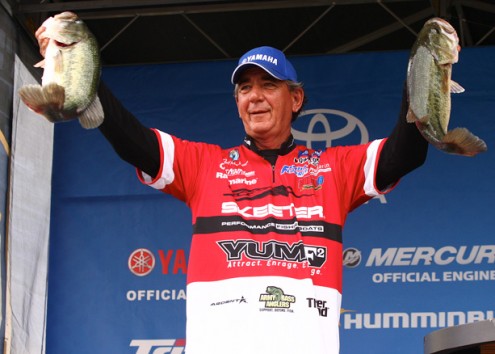
I didn’t win the 2014 Bassmaster Elite at Lake Dardanelle in Arkansas. I placed 17th in the final standings, which is disappointing, but I did bring in the biggest sack of the tournament on Day 2 – 25 pounds, 5 ounces! Anytime you have a bag like that, it’s worth talking about.
Conditions made fishing tough. Rain beat our butts every day on that Arkansas River impoundment, and conditions changed daily. Water levels shifted – up 4 or 5 inches one day, down 4 to 6 inches the next day – every day.
Drawing water or a water level change for any reason alters what the fish do daily, and sometimes even hour-by-hour. That made for tough fishing at times. Subtle changes in conditions could take place, and they weren’t always immediately evident. We had to make adjustments every day.
I did much of my fishing on Lake Dardanelle flipping a Booyah jig and Yum Chunk trailer. I used two main colors, black-and-blue and green pumpkin. I fished black-and-blue much of the time in muddy water and green pumpkin in situations where there wasn’t so much stain.
During practice I’d found a good fish and knew it was still there, so that’s where I started on Day 2, hoping to improve on my 11-pound total from the first day. I pitched that jig to the laydown, and, sure enough, the fish was still there. But I lost him! As I stood there staring at the laydown, however, I noticed the water level was lower than it had been.
 So I played a hunch. I moved to another spot with deeper water up along a rocky ledge. It didn’t have a laydown, but that didn’t matter. I caught a fish between 5 and 6 pounds right away.
So I played a hunch. I moved to another spot with deeper water up along a rocky ledge. It didn’t have a laydown, but that didn’t matter. I caught a fish between 5 and 6 pounds right away.
The spot reminded me of another – a spot that hadn’t received much fishing pressure to my knowledge. I arrived there at 11 a.m. It took me two or three hours to fish the entire area, working up one side and down the other. Wherever I found the right scenario – where the water dropped – the fish would bite me. I didn’t get a lot of bites, but every one was a big one.
I could almost call my bites that day!
The fish were on wood and in front of boulders. But with the water falling, they had pulled to slightly deeper water than they had been for the past few days. The key to flipping the wood was to pitch to the middle of the tree and work it on out to deeper water instead of pitching all the way up to the bank.
Working the current was also a key factor. The fish that were holding near boulders were always positioned at the front of the boulder – not on the side, not behind it. They were right out front.
And they were extremely aggressive! You had no doubt when one bit. That made it a lot of fun. I would pitch in front of the rock and let the current flush the bait toward the boulder. The bass wouldn’t hesitate. They came up to get it. I would pick up the line and instead of the jig being up on that boulder, it would be 3 feet out front – with a fish on it!
My Booyah jig and Yum craw presented a large profile, and the dark silhouette was something the bass could see even with limited visibility. Determining how the fish were reacting to the changing water levels was equally important in pinpointing the fish.
It’s not often you get a sack of fish more than 25 pounds on Dardanelle – or anywhere else, for that matter.





